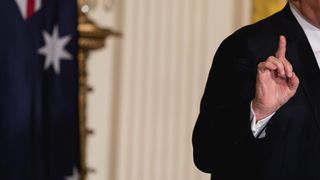“If he’s at all hostile, he won’t be there long.” These 19 March 2024 comments from former president Donald Trump about Australian Ambassador to the United States Kevin Rudd were an incendiary warning shot to the Albanese government and a glimpse into the potential challenges it may have to navigate if Trump reclaims the presidency in November. The presidential frontrunner’s rhetoric came in response to Rudd labelling Trump “the most destructive president in history” prior to his ambassadorship in 2020. Yet Trump’s comments have implications not only for Rudd’s viability as an ambassador if Trump is re-elected, but also raise broader questions about how ideologically opposed — but strategically aligned — governments can cooperate.
How have diplomatic tensions between Australia and the United States played out in the past?
A Trump reelection would not produce the first Labor/Republican government dynamic in the Australia-US alliance’s history. December 1972 may offer the most apt parallel to the potential dynamic between an Albanese government and a second Trump administration.
Recently re-elected Republican President Richard Nixon was preparing for his second inauguration, and Gough Whitlam had been sworn in as the first Labor Prime Minister since 1949. Much like the current Australia and US concern over growing Chinese influence in the Indo-Pacific, in 1972 both nations held a shared geopolitical interest in the same region, with the Vietnam War stumbling to its conclusion.
On 5 December 1972, the same date that Whitlam was sworn into government, Nixon ordered the infamous ‘Christmas Bombings’ — an eleven-day bombing campaign over North Vietnam. Peace negotiations had stagnated after the US had reached a deal with North Vietnam in October of 1972, prior to the November election, that was then rejected by South Vietnam. Nixon justified the attack, which caused 2000 civilian deaths, as an effort to bring North Vietnam back to the negotiating table whilst simultaneously upholding an image of US strength; Nixon would later characterise it as “peace with honour.”
Not yet two weeks into his prime ministership, Whitlam was presented with the immediate challenge of balancing ideology and diplomacy: Labor had committed to an anti-Vietnam War policy from the start of Australian military engagement in 1965, and sought to increase Australian independence from the United States. Whitlam withdrew the last of Australia’s Vietnam troops on 17 December 1972. He stated in January 1973: “Adherence to ANZUS (Australia, New Zealand, United States Security Treaty) does not in itself constitute a foreign policy.” Still, the United States remained Australia’s primary security partner and, until 1971, was Australia’s largest trade partner.
In response to the US bombing campaign, Whitlam wrote a letter to Nixon in which he voiced Australia’s disapproval of the bombing and signalled an intention to publicly appeal for the United States and North Vietnam to return to the negotiating table. To Nixon and his National Security Advisor Henry Kissinger, Canberra had equated Washington to Hanoi. For that misdeed, Whitlam was frozen out from Washington for half a year. Nixon did not even dignify Whitlam’s letter with a formal response. The freeze would further manifest after Whitlam’s letter of condolence to Nixon for the death of Lyndon Johnson in January 1973 went unanswered and, more importantly, in Nixon’s hesitancy to invite Whitlam to the White House when he was scheduled to be in Washington DC. A contemporary New York Times article remarked that Whitlam “virtually had to invite himself.” Within one month of Whitlam’s tenure, Australia had lost an intrinsic privilege afforded by the alliance: the president’s ear.
Balancing ideology with interpersonal diplomacy
The ideological contrast between a Republican administration and Labor government certainly contributed to a mutual suspicion from the beginning of Whitlam’s tenure. US concern over the anti-Vietnam War Labor party coming into power, following decades of ideologically-aligned Coalition government, preceded Nixon’s term. But these broad ideological party differences cannot wholly account for why Nixon and Whitlam’s relationship fractured so quickly, and remained broken for so long.
Rather, failures of diplomacy at the interpersonal level meant that a singular divide over one policy resulted in effectively a complete breakdown in communication between the most prominent figures of the alliance. Whitlam’s shortcoming came from his government’s failure to adjust from the role of opposition to leadership. Then Australian Minister for Trade and Industry, Jim Cairns, publicly accused Nixon of initiating peace negotiations “for electoral purposes,” stating that “now they have served those purposes, the war goes on, and the bombing and killing are intensified.” This antagonistic commentary may have been appropriate for an opposition politician with a purely domestic audience, but was unconstructive from a national leader with greater diplomatic responsibility.
For his part, Nixon, increasingly beset by the Watergate scandal, inherently assumed that any negative commentary from the press and foreign leaders alike was equally hostile. This sense of paranoia further precluded the development of interpersonal diplomatic relations with a prime minister already opposed to Nixon’s policies. Nixon’s freeze-out of Whitlam was thus not calculated wholly on an ideological difference, but a failure to initiate interpersonal diplomacy that could have soothed tensions over policy differences.
What lessons can be learned from this history?
This history shows that while ideological misalignment can initiate division between governments, a failure to establish personal diplomatic relations between leaders may perpetuate these disputes.
Ambassadorial selection can help to mitigate possible tensions. Former Australian Ambassador to the United States Joe Hockey is an example, and was widely recognised as establishing a productive relationship with Trump after the hostile initiation of relations between him and then-Prime Minister Malcolm Turnbull in 2017. Similarly, the revival of Whitlam and Nixon’s diplomatic engagement coincided with Marshall Green being appointed as US Ambassador to Australia. Green, a respected career foreign service official, symbolised Washington’s prioritisation of Australia, given that the ambassadorship for the previous twenty years had been occupied by relatively unimportant ex-politicians. Green was able to effectively communicate to the White House how Nixon’s freeze of Whitlam did nothing to improve Canberra’s perception of Washington, and ultimately posed a threat to US defense interests in Australia. His effort to revitalise diplomatic engagements culminated in Whitlam being received at the White House on 30 July 1973.
For the Albanese government, replacing Rudd with a figure better suited to interacting with a Trump administration would not be without precedent. In 2019, the United Kingdom’s Ambassador to the United States resigned following a leak of diplomatic cables from Washington DC to London that described the Trump administration as “inept,” “insecure,” and “incompetent.” Trump effectively forced the ambassador’s hand by publicly expressing that the White House “will no longer deal with him.”
It should be noted that Rudd would not be the first person in Trump’s orbit with a history of disparaging comments made against the former president. Trump’s speculated vice presidential shortlist, for example, is a list almost exclusively composed of former dissenters. This includes even the most doggedly loyal to Trump, including Elise Stefanik, JD Vance and Byron Donalds. That is not to say that Rudd and Albanese must become acolytes to the president, nor should they. But history shows that past criticism does not necessarily prevent future cooperation with Trump.
The decision to keep or dismiss Rudd will ultimately be left to Prime Minister Albanese. The government’s current position is that Rudd will remain the ambassador regardless of the US presidential election result in November. Either way, the principal consideration must be a pragmatic focus on Australia’s national interest. As Whitlam’s shortcomings demonstrated, pragmatism in a diplomatic relationship between ideologically opposed governments requires an awareness of political sensitivities beyond partisan domestic agendas. This is the core difference between a prime minister acting as the leader of a partisan political party in front of a national audience and the responsibility of being a country’s representative on the global stage. Rudd, by most accounts, has so far been an effective ambassador in his time working with an ideologically-aligned Democratic administration as well as a Republican-led Congress.
Whether he and Albanese can maintain this cooperation (and for Rudd, his job) with a change in US administration come January 2025 may depend on their ability to separate their partisan ideology from their diplomatic interactions.






